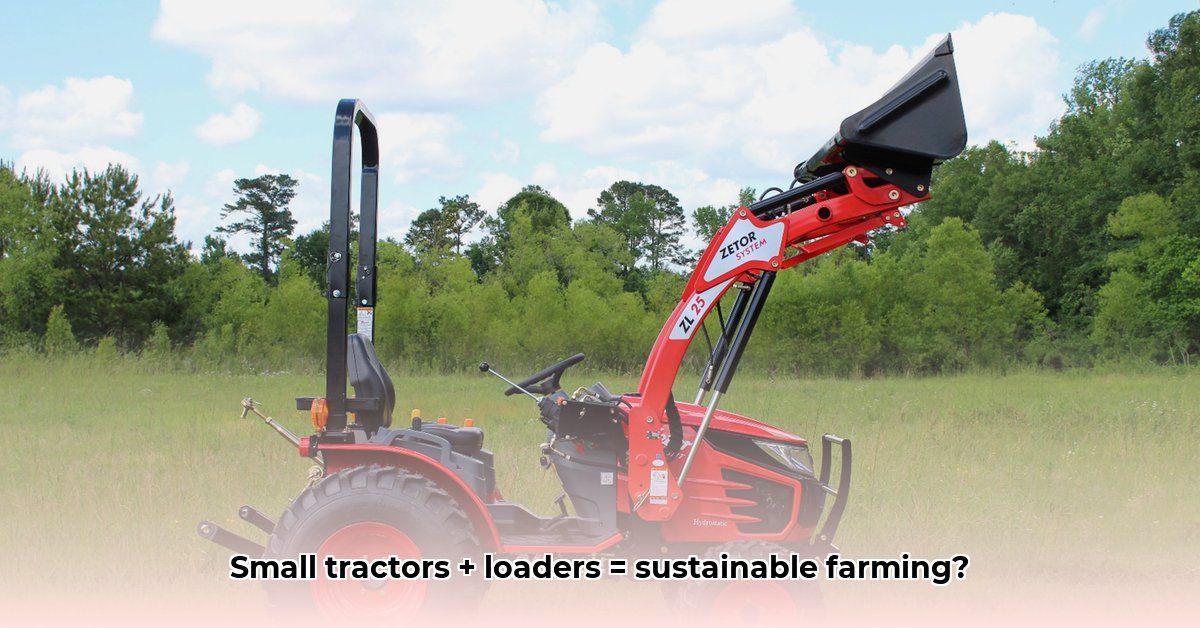
Choosing the right equipment is critical for efficient and sustainable farming. Small tractors with loaders offer a powerful yet efficient solution, particularly for smaller operations. This guide provides a step-by-step approach to selecting the ideal tractor, aligning your needs with sustainable agricultural practices. For more detailed information on tractor loaders, check out this helpful resource.
Understanding Your Farming Operation: A Personalized Blueprint
Before exploring tractor models, thoroughly assess your individual farm’s needs. This crucial planning phase prevents costly mistakes and ensures a matched tractor investment.
1. Land Assessment: What’s the acreage? Is the terrain flat, hilly, or rocky? This directly influences the required horsepower. Larger areas generally demand more powerful tractors, while smaller, more maneuverable machines are perfect for smaller plots. Overestimating horsepower leads to fuel inefficiency.
2. Task Definition: What are the primary tractor applications? Will you use it for loading, mowing, tilling, or a combination? This dictates essential features. For example, heavy lifting necessitates a robust hydraulic system, while a versatile power take-off (PTO) is crucial for attachments like mowers.
3. Budgetary Planning: Tractor purchase is a substantial investment. Set a realistic budget encompassing initial costs, ongoing maintenance, fuel, and potential repairs. Explore financing options and include the cost of necessary attachments. Don't underestimate these ongoing costs.
Key Features for Sustainable Tractor Selection: Spec Deep Dive
Now, let's examine specific features impacting the sustainability and efficiency of your small tractor with a loader.
Horsepower (HP): This indicates engine power. More horsepower generally equates to increased capability but also higher fuel consumption. Strive for a balance—sufficient power for your tasks without unnecessary fuel waste. A slightly less powerful yet fuel-efficient model may ultimately be more cost-effective if it fulfills your needs.
Hydraulic System: This powers the loader and implements. A higher flow rate ensures faster and more efficient operation. For frequent heavy lifting, a higher-capacity hydraulic system is beneficial.
Transmission: Hydrostatic transmissions offer smoother operation and easier maneuvering, advantageous in tight spaces. Gear transmissions might offer slightly better fuel efficiency under consistent speed requirements.
Loader Capacity: This indicates the maximum weight the loader can lift safely. Select a capacity comfortably handling your heaviest loads with a margin for safety.
Three-Point Hitch: This crucial attachment point connects implements like tillers or mowers. Ensure compatibility between the tractor’s three-point hitch and your intended implements.
Fuel Efficiency: Fuel costs significantly impact operations. Consider tractors with fuel-efficient engines. Explore alternative fuels if compatible. Efficient driving habits, such as minimizing idling, are also crucial for fuel economy. Isn't reducing fuel consumption a key goal of sustainable farming?
A Step-by-Step Guide to Tractor Selection: Your Actionable Plan
This structured approach ensures an informed purchase decision.
Step 1: Comprehensive Needs Assessment: List all farming tasks, their frequency, and estimated time requirements. Consider land size and terrain type. This detailed assessment forms the basis of your tractor selection.
Step 2: Horsepower Requirements: Based on your needs assessment, determine the horsepower needed for each task. Online resources and calculators can assist. Slightly underestimating horsepower is often preferable to overestimating, especially regarding fuel efficiency.
Step 3: Model Research: Research different brands and models of small tractors with loaders. Examine specifications, fuel efficiency ratings, and user reviews. Prioritize models matching your horsepower needs and desired features.
Step 4: Objective Feature Comparison: Create a comparison chart to evaluate models objectively. Include horsepower, hydraulic flow rate, loader capacity, transmission type, three-point hitch, and fuel efficiency data.
Step 5: Dealership Visits and Test Drives: Visit dealerships to test drive various models. Seek advice from experienced farmers or staff. Don't underestimate the value of hands-on experience.
Step 6: Financing and Total Cost Analysis: Consider financing options and calculate the total cost of ownership. This includes purchase price, maintenance, fuel costs, and potential repairs. Long-term costs dramatically impact true sustainability.
Step 7: Informed Purchase Decision: After thorough research, comparison, and testing, make your purchase. Ensure you receive necessary warranties and documentation.
Sustainable Practices with Your New Tractor: Maximizing Environmental Impact
Purchasing a fuel-efficient tractor is only one element of sustainable farming. Implement these key practices to maximize the environmental benefits:
Precision Agriculture: Utilize GPS-guided implements for optimized fertilizer and pesticide application. This reduces waste and minimizes environmental impact. Isn't precision a cornerstone of efficient resource management?
Fuel-Efficient Operation: Practice fuel-efficient driving techniques, such as avoiding unnecessary idling and selecting the appropriate gear. Regular engine maintenance significantly contributes to fuel efficiency. Consider lower-emission fuels where available.
Attachment Versatility: Invest in versatile attachments to maximize the tractor’s usage. This reduces the need for multiple specialized machines, minimizing your overall environmental footprint. Consolidating functions reduces both costs and environmental impact.
Responsible Disposal: When replacing your tractor, ensure responsible disposal or recycling according to local regulations. Sustainable farming practices extend to the entire lifecycle of your equipment.
By following these steps, you can select a small tractor with a loader that perfectly aligns with your needs and sustainable farming goals, creating a long-term, environmentally responsible, and profitable operation.